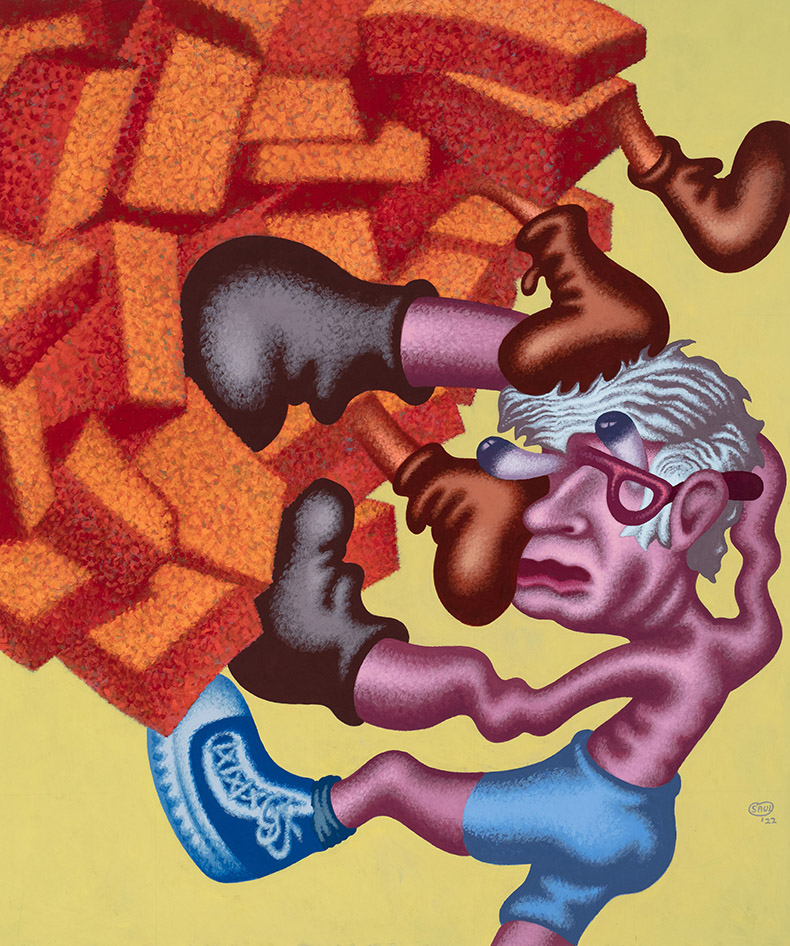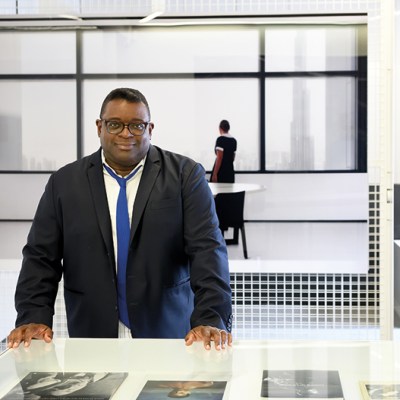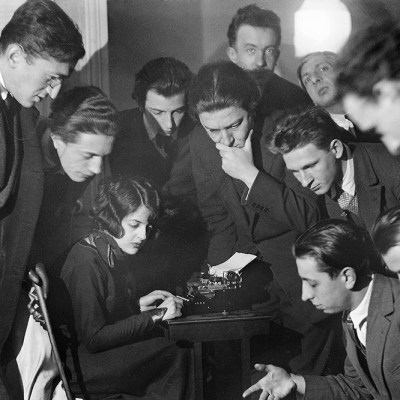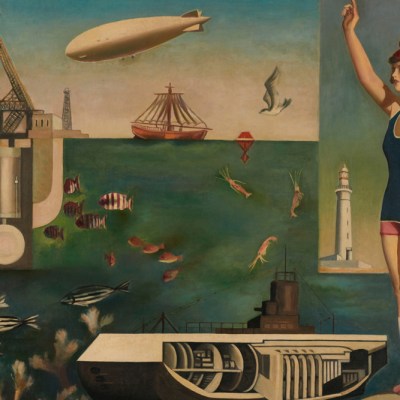A wiry, bespectacled man with a mop of grey hair is engaged in a boxing match against what looks like a pile of red bricks. He is backed into a corner; his eyes are popping out of his head with exertion. ‘Unfortunately, I forgot to plan the picture so I would win the boxing match and consequently I’m getting beat up pretty bad,’ writes the American artist Peter Saul in the notes accompanying his latest exhibition at Michael Werner Gallery in London.
The painting – one of a dozen recent canvases and works on paper included in the show – is entitled Peter Saul versus Modern Art, Round One (2022). The brick-like shapes are in fact supposed to represent a Cubist artwork, perhaps Duchamp’s abstracted nude descending a staircase, which Saul has parodied on a few occasions before. The man about to get knocked out is, of course, the 87-year-old artist himself. In a way, this combative encounter sums up his entire career. For the past six decades, Saul has defined his artistic approach in opposition to prevailing trends – from abstraction to conceptualism to the more loosely defined (and currently dominant) category of political or ‘socially engaged’ art.
Peter Saul in his studio in Germantown, New York, 2022. Courtesy Michael Werner Gallery, New York and London.

‘I was hoping it was attractive to be rebellious,’ says Saul with a chuckle. We have sat down to speak ahead of the opening of his exhibition, and I am struck by the mild-mannered character of an artist whose entire creative output seems designed to confront and to shock. His cartoonishly rendered scenes teem with blood and guts and excrement and acts of terrifying violence. Often they feature real people – Angela Davis on a crucifix; George W. Bush sticking his finger into the mouth of a mutilated corpse at Abu Ghraib. No content is off limits, including racially and sexually offensive imagery. ‘To be not rebellious would be really boring, in my opinion, for the viewer,’ Saul explains, as if he were making the most obvious and uncontroversial point in the world.
Superman in Heaven (2022), Peter Saul. Photo: Kevin Noble; courtesy Michael Werner Gallery, New York and London; © the artist.

Making his pictures interesting for the viewer – ‘interesting to look at, not just to know about, like most modern art’ – is the artist’s guiding motto. He politely insists that the subject matter, rather than formal or symbolic concerns, is all he considers when deciding what to depict. On the recurring motif of Superman, for instance, who has cropped up since his earliest paintings and appears in one recent canvas as the devil’s conjoined twin: ‘As long as I can think of him doing something fresh, he’s more interesting than the guy next door. Superman reading the newspaper is superior to just a man reading the newspaper.’ (Although Saul’s Supermen, it should be noted, are more likely to be found in the electric chair or being flattened by some other torturous device than perusing the Sunday papers.)
Despite – or perhaps thanks to – his contrarian impulse, Saul has amassed a devoted following. Over the decades he has shown regularly in galleries, especially in Chicago and New York, and in 2020 he was the subject of a career-spanning retrospective at the New Museum. The exhibition at Michael Werner comes on the heels of the publication of a sumptuous monograph by Rizzoli. Advocates for the artist have tended to emphasise the political dimension of his work, arguing that the horrors he portrays are a kind of fun-house mirror: a grotesquely distorted reflection of the ugliest parts of contemporary society. Saul appears nonplussed by such analyses. ‘I didn’t think I’d ever meet any interpreters,’ he says. ‘I didn’t expect to ever meet anyone who worked for a magazine.’
Peter Saul versus Modern Art, Round One (2022), Peter Saul. Photo: Kevin Noble; courtesy Michael Werner Gallery, New York and London; © the artist.

Saul ascribes his success simply to meeting and getting along with good gallerists: ‘I’ve been extremely lucky. My personality is the kind of personality that art dealers like.’ It leaves him free to forget about what people think of his work and keeping making exactly what he wants. ‘I don’t want to do anything else. I sincerely don’t want to be employed. I don’t want anyone to tell me what to do,’ he says. Fortunately, a couple of months shy of his 88th birthday, he is still brimming with ideas for new pictures. He plans to do a whole series on global warming – ‘sweating people, tormented by the end of the world, the Earth has changed its shape, everything’s gone screwy’. But for starters, he is gearing up for a second round of the boxing match versus modern art. This time Saul intends to win.
‘Peter Saul: New Work’ is at Michael Werner Gallery, London, until 10 September.



